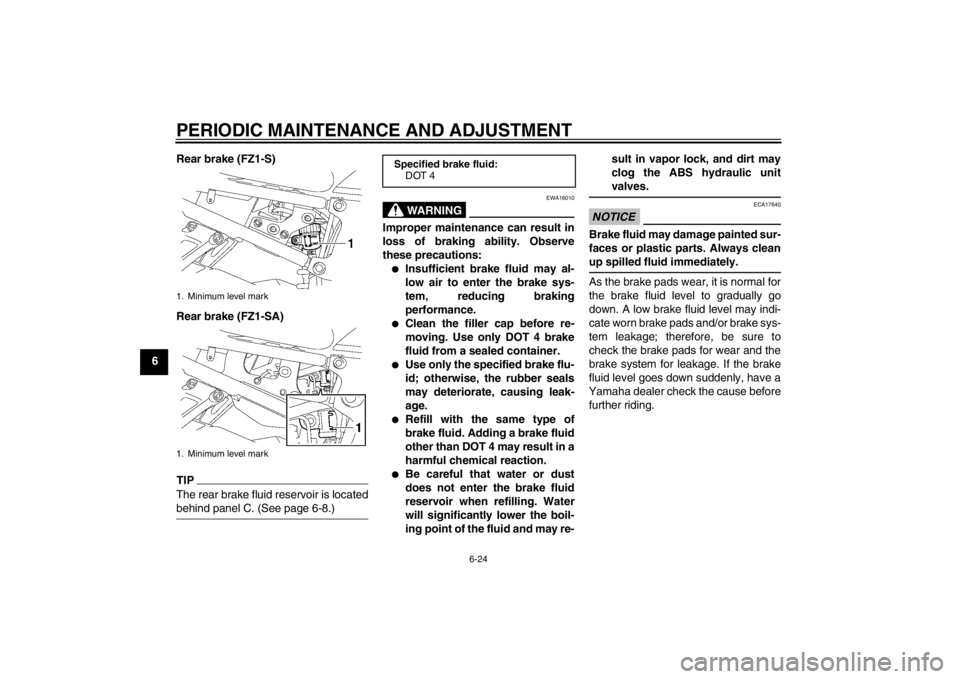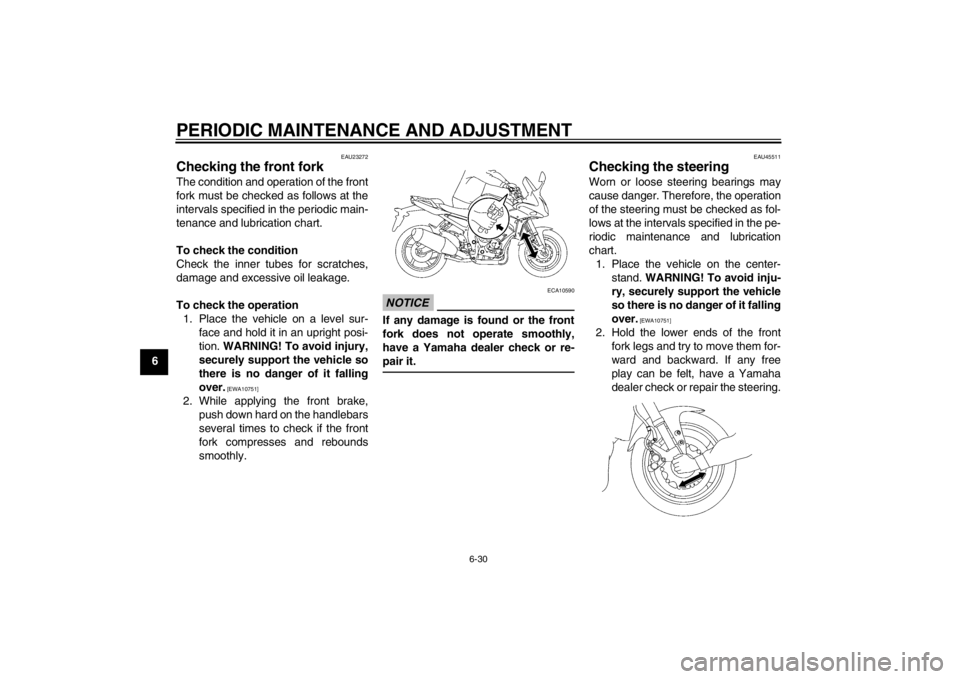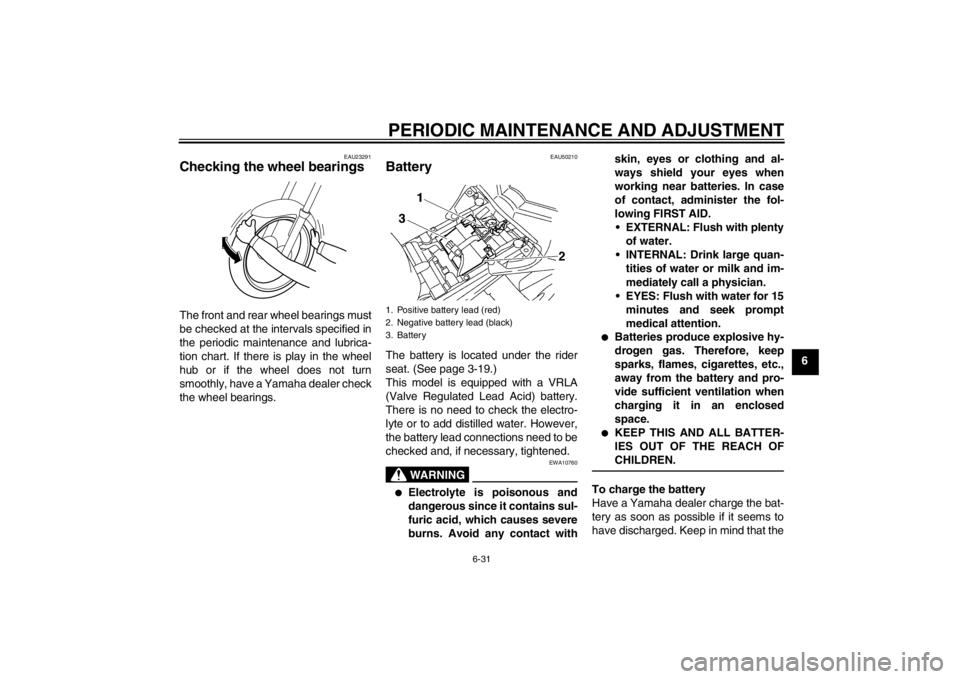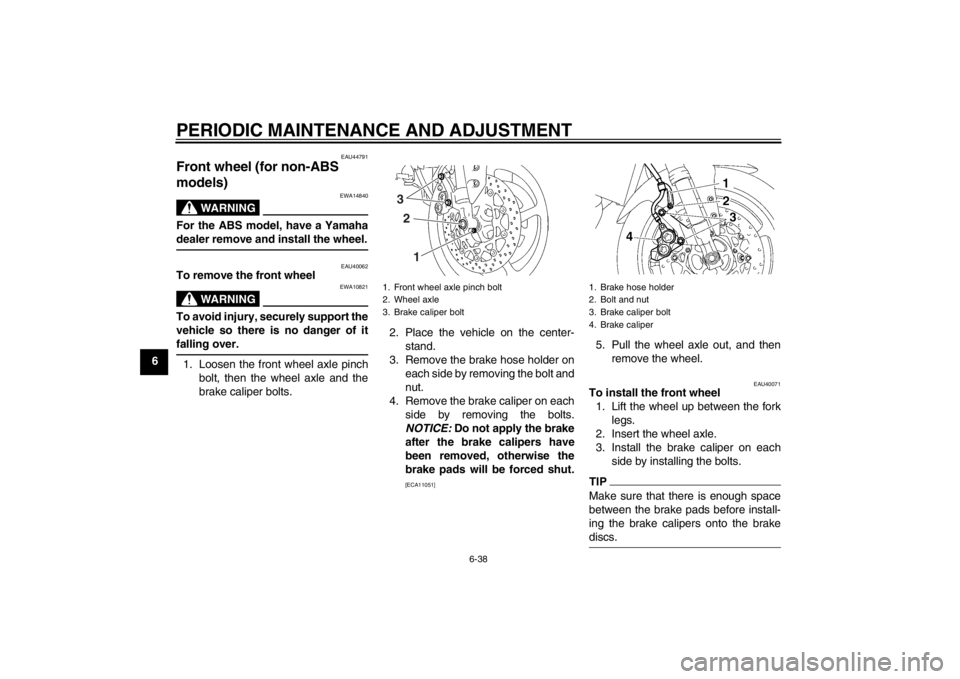Page 71 of 106

PERIODIC MAINTENANCE AND ADJUSTMENT
6-21
6
EAU22081
Adjusting the clutch lever free
play The clutch lever free play should mea-
sure 10.0–15.0 mm (0.39–0.59 in) as
shown. Periodically check the clutch le-
ver free play and, if necessary, adjust it
as follows.
To increase the clutch lever free play,
turn the clutch lever free play adjusting
bolt in direction (a). To decrease the
clutch lever free play, turn the adjusting
bolt in direction (b).
TIPIf the specified free play cannot be ob-
tained as described above or if the
clutch does not operate correctly, have
a Yamaha dealer check the internal
clutch mechanism.
EAU37913
Checking the brake lever free
play There should be no free play at the
brake lever end. If there is free play,
have a Yamaha dealer inspect the
brake system.
WARNING
EWA14211
A soft or spongy feeling in the brake
lever can indicate the presence of air
in the hydraulic system. If there is air
in the hydraulic system, have a
Yamaha dealer bleed the system be-
fore operating the vehicle. Air in the
hydraulic system will diminish the
1. Clutch lever free play adjusting bolt
2. Clutch lever free play
1. No brake lever free play
1
U1CAE1E0.book Page 21 Tuesday, September 13, 2011 5:02 PM
Page 74 of 106

PERIODIC MAINTENANCE AND ADJUSTMENT
6-24
6Rear brake (FZ1-S)
Rear brake (FZ1-SA)
TIPThe rear brake fluid reservoir is located
behind panel C. (See page 6-8.)
WARNING
EWA16010
Improper maintenance can result in
loss of braking ability. Observe
these precautions:●
Insufficient brake fluid may al-
low air to enter the brake sys-
tem, reducing braking
performance.
●
Clean the filler cap before re-
moving. Use only DOT 4 brake
fluid from a sealed container.
●
Use only the specified brake flu-
id; otherwise, the rubber seals
may deteriorate, causing leak-
age.
●
Refill with the same type of
brake fluid. Adding a brake fluid
other than DOT 4 may result in a
harmful chemical reaction.
●
Be careful that water or dust
does not enter the brake fluid
reservoir when refilling. Water
will significantly lower the boil-
ing point of the fluid and may re- sult in vapor lock, and dirt may
clog the ABS hydraulic unit
valves.
NOTICE
ECA17640
Brake fluid may damage painted sur-
faces or plastic parts. Always clean
up spilled fluid immediately.As the brake pads wear, it is normal for
the brake fluid level to gradually go
down. A low brake fluid level may indi-
cate worn brake pads and/or brake sys-
tem leakage; therefore, be sure to
check the brake pads for wear and the
brake system for leakage. If the brake
fluid level goes down suddenly, have a
Yamaha dealer check the cause before further riding.
1. Minimum level mark
1. Minimum level mark
Specified brake fluid: DOT 4
U1CAE1E0.book Page 24 Tuesday, September 13, 2011 5:02 PM
Page 77 of 106
![YAMAHA FZ1 S 2012 Owners Manual PERIODIC MAINTENANCE AND ADJUSTMENT
6-27
6
may contain substances that
could damage the O-rings.
[ECA11111]
EAU23095
Checking and lubricating the
cables The operation of all control cables and
the co YAMAHA FZ1 S 2012 Owners Manual PERIODIC MAINTENANCE AND ADJUSTMENT
6-27
6
may contain substances that
could damage the O-rings.
[ECA11111]
EAU23095
Checking and lubricating the
cables The operation of all control cables and
the co](/manual-img/51/49978/w960_49978-76.png)
PERIODIC MAINTENANCE AND ADJUSTMENT
6-27
6
may contain substances that
could damage the O-rings.
[ECA11111]
EAU23095
Checking and lubricating the
cables The operation of all control cables and
the condition of the cables should be
checked before each ride, and the ca-
bles and cable ends should be lubricat-
ed if necessary. If a cable is damaged
or does not move smoothly, have a
Yamaha dealer check or replace it.
WARNING! Damage to the outer
housing of cables may result in in-
ternal rusting and cause interfer-
ence with cable movement. Replace
damaged cables as soon as possi-
ble to prevent unsafe conditions.[EWA10711] EAU23114
Checking and lubricating the
throttle grip and cable The operation of the throttle grip should
be checked before each ride. In addi-
tion, the cable should be lubricated by a
Yamaha dealer at the intervals speci-
fied in the periodic maintenance chart.
The throttle cable is equipped with a
rubber cover. Make sure that the cover
is securely installed. Even though the
cover is installed correctly, it does not
completely protect the cable from water
entry. Therefore, use care not to pour
water directly onto the cover or cable
when washing the vehicle. If the cable
or cover becomes dirty, wipe clean with
a moist cloth.
Recommended lubricant:
Yamaha Chain and Cable Lube or
engine oil
U1CAE1E0.book Page 27 Tuesday, September 13, 2011 5:02 PM
Page 79 of 106
PERIODIC MAINTENANCE AND ADJUSTMENT
6-29
6
EAU23213
Checking and lubricating the
centerstand and sidestand The operation of the centerstand and
sidestand should be checked before
each ride, and the pivots and metal-to-
metal contact surfaces should be lubri-
cated if necessary.
WARNING
EWA10741
If the centerstand or sidestand does
not move up and down smoothly,
have a Yamaha dealer check or re-
pair it. Otherwise, the centerstand or
sidestand could contact the ground
and distract the operator, resulting
in a possible loss of control.
Recommended lubricants:Brake lever:
Silicone grease
Clutch lever:
Lithium-soap-based grease
Recommended lubricant:Lithium-soap-based grease
U1CAE1E0.book Page 29 Tuesday, September 13, 2011 5:02 PM
Page 80 of 106

PERIODIC MAINTENANCE AND ADJUSTMENT
6-30
6
EAU23272
Checking the front fork The condition and operation of the front
fork must be checked as follows at the
intervals specified in the periodic main-
tenance and lubrication chart.
To check the condition
Check the inner tubes for scratches,
damage and excessive oil leakage.
To check the operation1. Place the vehicle on a level sur- face and hold it in an upright posi-
tion. WARNING! To avoid injury,
securely support the vehicle so
there is no danger of it falling
over.
[EWA10751]
2. While applying the front brake, push down hard on the handlebars
several times to check if the front
fork compresses and rebounds
smoothly.
NOTICE
ECA10590
If any damage is found or the front
fork does not operate smoothly,
have a Yamaha dealer check or re-
pair it.
EAU45511
Checking the steering Worn or loose steering bearings may
cause danger. Therefore, the operation
of the steering must be checked as fol-
lows at the intervals specified in the pe-
riodic maintenance and lubrication
chart.1. Place the vehicle on the center- stand. WARNING! To avoid inju-
ry, securely support the vehicle
so there is no danger of it falling
over.
[EWA10751]
2. Hold the lower ends of the front fork legs and try to move them for-
ward and backward. If any free
play can be felt, have a Yamaha
dealer check or repair the steering.
U1CAE1E0.book Page 30 Tuesday, September 13, 2011 5:02 PM
Page 81 of 106

PERIODIC MAINTENANCE AND ADJUSTMENT
6-31
6
EAU23291
Checking the wheel bearings The front and rear wheel bearings must
be checked at the intervals specified in
the periodic maintenance and lubrica-
tion chart. If there is play in the wheel
hub or if the wheel does not turn
smoothly, have a Yamaha dealer check
the wheel bearings.
EAU50210
Battery The battery is located under the rider
seat. (See page 3-19.)
This model is equipped with a VRLA
(Valve Regulated Lead Acid) battery.
There is no need to check the electro-
lyte or to add distilled water. However,
the battery lead connections need to be
checked and, if necessary, tightened.
WARNING
EWA10760
●
Electrolyte is poisonous and
dangerous since it contains sul-
furic acid, which causes severe
burns. Avoid any contact withskin, eyes or clothing and al-
ways shield your eyes when
working near batteries. In case
of contact, administer the fol-
lowing FIRST AID.
EXTERNAL: Flush with plenty of water.
INTERNAL: Drink large quan- tities of water or milk and im-
mediately call a physician.
EYES: Flush with water for 15 minutes and seek prompt
medical attention.
●
Batteries produce explosive hy-
drogen gas. Therefore, keep
sparks, flames, cigarettes, etc.,
away from the battery and pro-
vide sufficient ventilation when
charging it in an enclosed
space.
●
KEEP THIS AND ALL BATTER-
IES OUT OF THE REACH OF
CHILDREN.
To charge the battery
Have a Yamaha dealer charge the bat-
tery as soon as possible if it seems to
have discharged. Keep in mind that the
1. Positive battery lead (red)
2. Negative battery lead (black)
3. Battery
U1CAE1E0.book Page 31 Tuesday, September 13, 2011 5:02 PM
Page 84 of 106

PERIODIC MAINTENANCE AND ADJUSTMENT
6-34
62. Unhook the battery band, and then
remove the battery cover.
3. Remove the starter relay cover by pulling it upward. 4. Remove the blown fuse, and then
install a new fuse of the specified
amperage. WARNING! Do not
use a fuse of a higher amperage
rating than recommended to
avoid causing extensive dam-
age to the electrical system and
possibly a fire.
[EWA15131]
5. Turn the key to “ON” and turn on the electrical circuit in question to
check if the device operates.
6. If the fuse immediately blows again, have a Yamaha dealer
check the electrical system.
7. Install the starter relay cover.
8. Install the battery cover, and then hook the battery band onto the
holder.
1. Battery band
2. Battery cover
1. Starter relay cover
2. Fuel injection system fuse
3. Fuel injection system spare fuse
2
1
3
Specified fuses:Main fuse:50.0 A
Headlight fuse:
25.0 A
Signaling system fuse: 10.0 A
Ignition fuse: 15.0 A
Fuel injection system fuse:
15.0 A
Taillight fuse: 10.0 A
Radiator fan fuse: 10.0 A × 2
Backup fuse:
10.0 A
ABS control unit fuse: FZ1-SA 10.0 A
ABS motor fuse: FZ1-SA 30.0 A
U1CAE1E0.book Page 34 Tuesday, September 13, 2011 5:02 PM
Page 88 of 106

PERIODIC MAINTENANCE AND ADJUSTMENT
6-38
6
EAU44791
Front wheel (for non-ABS
models)
WARNING
EWA14840
For the ABS model, have a Yamaha
dealer remove and install the wheel.
EAU40062
To remove the front wheel
WARNING
EWA10821
To avoid injury, securely support the
vehicle so there is no danger of it
falling over.1. Loosen the front wheel axle pinchbolt, then the wheel axle and the
brake caliper bolts. 2. Place the vehicle on the center-
stand.
3. Remove the brake hose holder on each side by removing the bolt and
nut.
4. Remove the brake caliper on each side by removing the bolts.
NOTICE: Do not apply the brake
after the brake calipers have
been removed, otherwise the
brake pads will be forced shut.
[ECA11051]
5. Pull the wheel axle out, and then remove the wheel.
EAU40071
To install the front wheel1. Lift the wheel up between the fork legs.
2. Insert the wheel axle.
3. Install the brake caliper on each side by installing the bolts.TIPMake sure that there is enough space
between the brake pads before install-
ing the brake calipers onto the brake
discs.
1. Front wheel axle pinch bolt
2. Wheel axle
3. Brake caliper bolt
3
2
1
1. Brake hose holder
2. Bolt and nut
3. Brake caliper bolt
4. Brake caliper
U1CAE1E0.book Page 38 Tuesday, September 13, 2011 5:02 PM